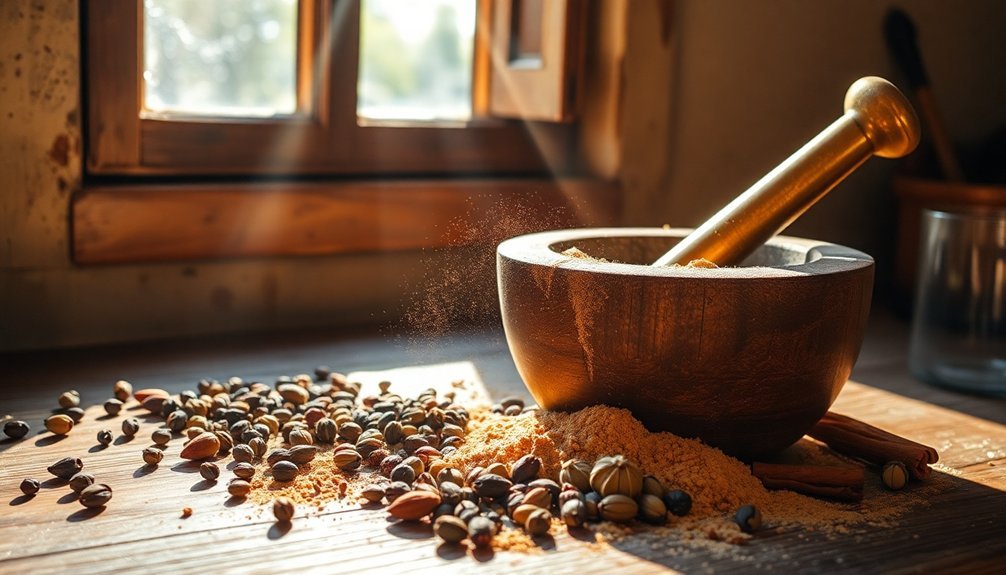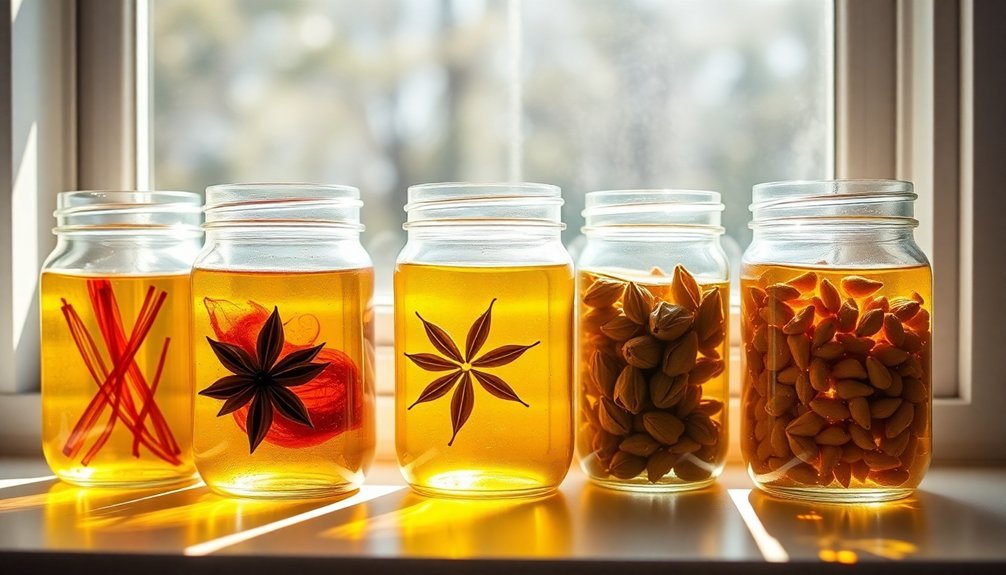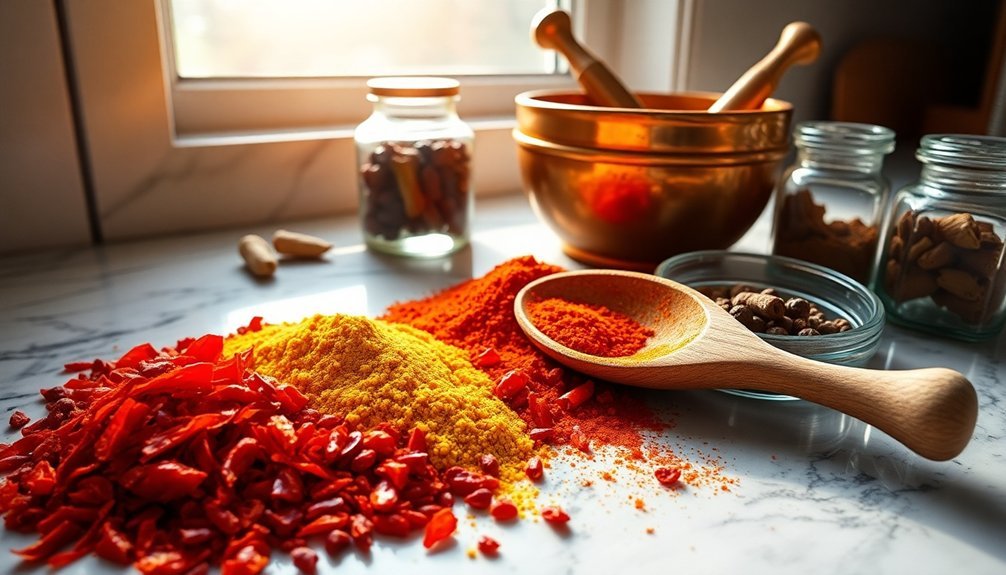Transform your sunlit kitchen into a spice powerhouse with these five essential prep tricks. Start by grinding whole spices just before cooking to maximize their essential oils and aroma. Toast your spices in a heavy cast-iron pan using precise timing – 30-45 seconds for fennel and coriander, 20-30 seconds for sesame seeds. Create solar-infused oils by placing dried herbs in sterilized jars under direct sunlight for 4-6 weeks. Layer your spices strategically, adding robust flavors early in cooking. Finally, balance heat levels by combining mild and intense peppers gradually. These fundamentals will open up a world of vibrant, sun-kissed flavors.
Unlock Fresh Whole Spice Power

Transform your cooking by harnessing the untapped potential of whole spices. Unlike pre-ground options, whole spices lock in essential oils and aromatic compounds, delivering superior flavor when you're ready to use them. You'll notice the difference immediately when you grind them fresh for each dish.
Start by selecting high-quality whole spices from trusted sources – look for organic or fair-trade options to guarantee the best results. You won't find any unwanted additives or preservatives that often lurk in pre-packaged blends. A mortar and pestle can help you achieve the perfect grind for maximum flavor extraction.
To maximize flavor, try lightly toasting your spices before grinding them. This simple step releases their natural oils and creates a richer taste profile. Keep your newly ground spices in airtight containers to maintain their potency, and remember to taste as you cook to perfect your seasoning.
Perfect Spice Toasting Times
When you're ready to elevate your spice game, mastering toasting times can make the difference between perfectly aromatic seasonings and burnt disappointment. You'll want to choose between stovetop or oven methods based on your spices and workflow needs. Using a heavy cast iron pan will give you the most even and controlled heating results.
| Spice Type | Stovetop Time | Oven Time (350°F) |
|---|---|---|
| Fennel/Coriander | 30-45 seconds | 5-6 minutes |
| Sesame Seeds | 20-30 seconds | 4-5 minutes |
| Star Anise | 45-60 seconds | 6-8 minutes |
| Peppercorns | Not recommended | Not recommended |
For stovetop toasting, keep your spices moving in a hot, dry pan until they darken and release their aroma. If you're using the oven method, sandwich your spices between two baking sheets for even heating. You'll know they're done when they turn golden brown and emit a rich, toasted scent.
Quick Solar Spice Infusions

Solar infusion offers a natural, energy-efficient way to extract flavors and essential oils from your favorite herbs and spices. You'll want to choose dried herbs for more potent results, though fresh ones work too if you're willing to use larger quantities. This method helps build blood levels and can improve overall wellness.
- Picture your herbs swimming in golden oil as sunlight streams through a clear glass jar on your windowsill.
- Imagine the gentle dance of chopped leaves and petals as you give the jar its daily shake.
- Visualize the rich amber color developing over weeks as nature does its work.
Start by filling a sterilized jar with your measured herbs, leaving no air pockets when you add the oil.
Label your creation, then let it bask in direct sunlight for 4-6 weeks, stirring daily for the first two weeks.
Once complete, strain through cheesecloth and your infused oil is ready to use.
Layering Spices for Solar Success
Successfully layering spices in solar cooking requires understanding how different seasonings interact and release their flavors over time. Start by toasting your spices in a small amount of oil to release their aromatic compounds, then add them to caramelized onions to guarantee even distribution throughout your dish.
You'll want to add robust spices like cumin, black pepper, and garlic salt early in the cooking process, allowing them to develop depth as they simmer.
Keep your frequently used spices nearby but protected from direct sunlight and heat. For the best results, grind whole spices just before use and create your own spice blends rather than using pre-mixed varieties.
Remember to adjust quantities based on your dish size – about two tablespoons total for large pot meals works well.
Balance Heat With Smart Blends

Creating perfectly balanced heat in your dishes requires understanding both the science of spice levels and the art of blending. You'll get the best results by starting with small amounts and adjusting gradually, whether you're working with Cuban hot sauces or traditional spice blends like Baharat.
- Layer your heat sources strategically – combine mild jalapeños with intense habaneros, or mix sweet paprika with fiery cayenne.
- Balance the burn with complementary ingredients – add honey for sweetness, yogurt for creaminess, or lime juice for brightness.
- Build depth through texture – use coarse spice blends that release flavor slowly while cooking, allowing heat to develop naturally.
Remember to taste as you go and consider your diners' preferences when crafting your perfect spice blend.
Frequently Asked Questions
Can Spices Lose Their Potency if Exposed to Direct Sunlight During Prep?
Yes, your spices will lose potency when exposed to direct sunlight during preparation. The UV rays break down their volatile oils, so you'll want to keep them in the shade to preserve their flavor.
How Long Can Toasted Spices Be Stored Before Losing Their Enhanced Flavors?
You'll want to use your toasted spices within 2-3 months for the best flavor. While they can last up to 2-3 years, their enhanced flavors begin degrading quickly, especially if they're ground after toasting.
Which Spices Should Never Be Combined Due to Flavor Conflicts?
You'll want to avoid mixing tarragon with cilantro or cumin, rosemary with cilantro, and sage with ginger. These combinations create harsh or conflicting flavors that can overpower and disrupt your dish's balance.
Do Different Cooking Oils Affect How Spices Release Their Flavors?
Yes, your choice of oil will affect spice flavoring. While all fats help release flavors, neutral oils won't compete with spices, whereas stronger-flavored oils like olive or sesame will add their own taste.
Can Humidity Levels Impact Spice Grinding and Storage Effectiveness?
Yes, humidity considerably impacts your spices. You'll notice they'll clump when grinding in moist conditions. Store them in airtight glass containers and consider adding rice or silica gel packs to maintain their quality.
In Summary
You've now got the key techniques to make your sun-cooked meals burst with spice-driven flavor. Whether you're crushing whole seeds, carefully toasting aromatics, creating quick solar infusions, building complex layers, or balancing heat levels, these tricks will transform your outdoor cooking. Take these tips to your next sunlit meal prep, and you'll create dishes that showcase the vibrant potential of properly prepared spices.





Leave a Reply